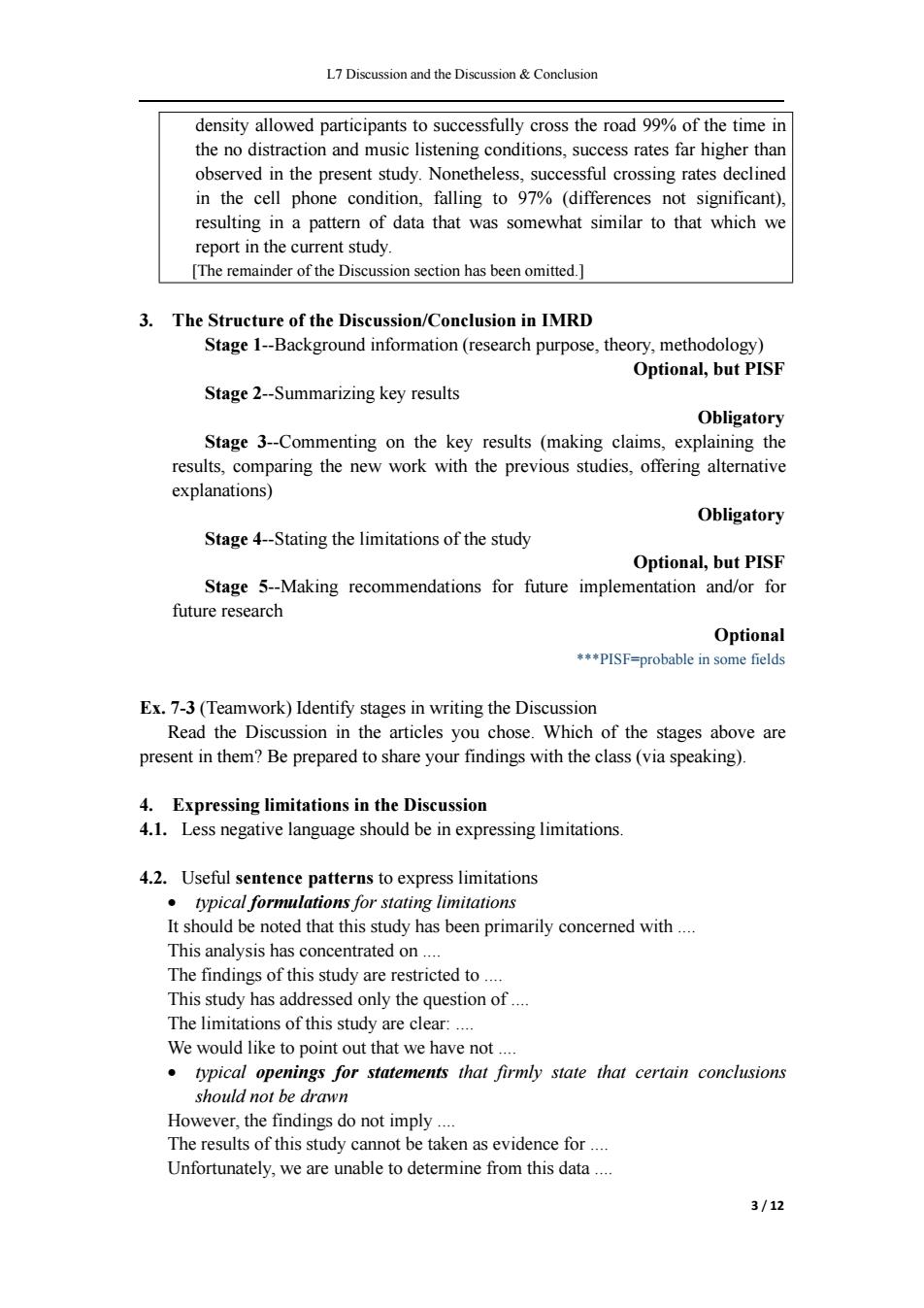正在加载图片...

L7 Discussion and the Discussion Conclusion density allowed participants to successfully cross the road 99%of the time in the no distraction and music listening conditions,success rates far higher than observed in the present study.Nonetheless,successful crossing rates declined in the cell phone condition,falling to 97%(differences not significant), resulting in a pattern of data that was somewhat similar to that which we report in the current study. [The remainder of the Discussion section has been omitted.] 3.The Structure of the Discussion/Conclusion in IMRD Stage 1--Background information(research purpose,theory,methodology) Optional,but PISF Stage 2--Summarizing key results Obligatory Stage 3--Commenting on the key results (making claims,explaining the results,comparing the new work with the previous studies,offering alternative explanations) Obligatory Stage 4--Stating the limitations of the study Optional,but PISF Stage 5--Making recommendations for future implementation and/or for future research Optional ***PISF=probable in some fields Ex.7-3(Teamwork)Identify stages in writing the Discussion Read the Discussion in the articles you chose.Which of the stages above are present in them?Be prepared to share your findings with the class(via speaking). 4.Expressing limitations in the Discussion 4.1.Less negative language should be in expressing limitations. 4.2.Useful sentence patterns to express limitations typical formulations for stating limitations It should be noted that this study has been primarily concerned with.... This analysis has concentrated on.... The findings of this study are restricted to.... This study has addressed only the question of.... The limitations of this study are clear:.... We would like to point out that we have not.... typical openings for statements that firmly state that certain conclusions should not be drawn However,the findings do not imply.... The results of this study cannot be taken as evidence for.... Unfortunately,we are unable to determine from this data.... 3/12L7 Discussion and the Discussion & Conclusion 3 / 12 density allowed participants to successfully cross the road 99% of the time in the no distraction and music listening conditions, success rates far higher than observed in the present study. Nonetheless, successful crossing rates declined in the cell phone condition, falling to 97% (differences not significant), resulting in a pattern of data that was somewhat similar to that which we report in the current study. [The remainder of the Discussion section has been omitted.] 3. The Structure of the Discussion/Conclusion in IMRD Stage 1--Background information (research purpose, theory, methodology) Optional, but PISF Stage 2--Summarizing key results Obligatory Stage 3--Commenting on the key results (making claims, explaining the results, comparing the new work with the previous studies, offering alternative explanations) Obligatory Stage 4--Stating the limitations of the study Optional, but PISF Stage 5--Making recommendations for future implementation and/or for future research Optional ***PISF=probable in some fields Ex. 7-3 (Teamwork) Identify stages in writing the Discussion Read the Discussion in the articles you chose. Which of the stages above are present in them? Be prepared to share your findings with the class (via speaking). 4. Expressing limitations in the Discussion 4.1. Less negative language should be in expressing limitations. 4.2. Useful sentence patterns to express limitations typical formulations for stating limitations It should be noted that this study has been primarily concerned with .... This analysis has concentrated on .... The findings of this study are restricted to .... This study has addressed only the question of .... The limitations of this study are clear: .... We would like to point out that we have not .... typical openings for statements that firmly state that certain conclusions should not be drawn However, the findings do not imply .... The results of this study cannot be taken as evidence for .... Unfortunately, we are unable to determine from this data